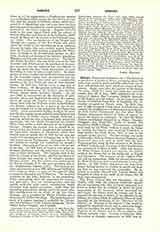

Sahara, Vicariate Apostolic of.—The Sahara is a vast desert of northern Africa, measuring about 932 miles from north to south and 2484 miles from east to west, and dotted with oases which are centers of population. Eight years after the journey of the famous Duveyrier (1859-61), which had important scientific results, Pius IX (August 6, 1868) appointed the Archbishop of Algiers, Msgr. Lavigerie, delegate Apostolic of the Sahara and the Sudan. In the same year the Jesuits established themselves at Laghouat, the extremity occupied by French arms. In 1871 they sent to Msgr. Lavigerie a long report in which they advocated the establishment of dispensaries and schools. In 1872 Father Charmetant and two other White Fathers (Missionary Fathers of Africa of Algiers) replaced the Jesuits at Laghouat. In 1873 the White Fathers established themselves at Biskra, Ouargla, Touggart, and Gerryville. Later a station was founded at Melili in Mzab. Two successive attempts were made by the White Fathers to reach the Sudan by crossing the Sahara, thus reaching Timbuktu, a large market for black slaves, there to join in the struggle against slavery. The first attempt was made in December, 1878, by Fathers Menoret, Paulmier, and Bouchand; they were slain in April, 1876, by their Touarag guides, being the first martyrs of the Society of White Fathers, and the cause of their beatification was introduced at Rome in 1909. After this disaster the White Fathers founded two stations, not farther north in the desert, but to the northeast, at Tripoli and Ghadames. The massacre of the explorer Flatters and his companions (1880-81) did not discourage the White Fathers in their second attempt to cross the Sahara. In 1881 Father Richard set out from Ghadames, having become so Arabian in speech and bearing that no one suspected his nationality. He intended to establish himself with Fathers Morat and Pouplard at Ghat in the midst of the desert, but all three were assassinated.
The White Fathers then left Ghadames. On March 25, 1890, while the Brussels conference against slavery was being held, Msgr. Lavigerie explained in a letter to Keller that to eradicate in Africa the great corporation of the Senoussi, which protected the slave-trade, the Sahara must be crossed, and he announced the opening at Biskra, at the entrance to the Sahara, of a house which he called the House of God, intended for the formation of the “Brothers of the Sahara”, or “Pioneers of the Sahara”, who would be engaged in charitable works and in extending hospitality to travellers, the sick, and fugitive slaves. The Pioneers of the Sahara had to live as religious, but without monastic vows. As early as February, 1891, the station at Ouargla, suppressed in 1876, was reestablished, and in October Father Harquard sent thither six armed “pioneers” who wrote to the cardinal: “We shall endeavor to hold high the banner of the Sacred Heart and the flag of France.” The White Sisters founded hospitals at Ghardaia and El Tbiod Sidi Cheikh, thus gaining the confidence of populations which were hostile to France. The Fourean-Lamy expedition of 1898, which succeeded in crossing the desert as far as Lake Tchad, opened wider avenues to the Catholic apostolate. The Prefecture Apostolic of the Sahara and the Sudan became a vicariate Apostolic on March 6, 1891, and in 1901 received new boundaries by which the Prefecture Apostolic of Ghardaia was separated from it. The twentieth degree of latitude forms the boundary between them. The vicariate governs 1000 European Catholics, 600 negro Catholics, 4000 catechumens, 40 missionaries, 15 sisters, 35 catechists; it has 12 churches or chapels, 10 schools, 7 orphanages, 3 leper-houses, 2 hospitals. The population of the Sahara is estimated at 4,000,000.
GEORGES GOYAU

